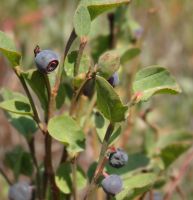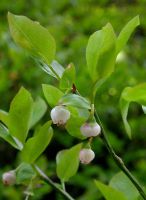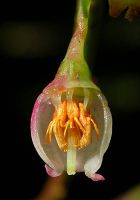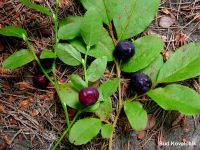Distribution: Occurring chiefly east of the Cascades crest in Washington; British Columbia to Oregon, east to the Rocky Mountains.
Habitat: Forest openings at middle elevations in the mountains
Flowers: May-August
Origin: Native
Growth Duration: Perennial
Conservation Status: Not of concern
Pollination: Bumblebees, bees
Deciduous, many-branched shrub 2-3 dm. tall, the branches strongly angled, greenish, usually puberulent.
Leaves ovate to elliptic-lanceolate, 1-3 cm. long, light green, strongly serrulate, strongly veiny on the lower surface.
Flowers single in the axils on pedicels 2-3 mm. long; calyx shallowly 5-lobed; corolla entire, pinkish, broadly urn-shaped; anthers with dorsal awns and apical, pore-bearing tubes; ovary inferior.
Fruit a berry, dark red to bluish, 5-8 mm. long.
Publication: Sp. Pl. 1: 349. 1753.
Vaccinium myrtillus L. var. oreophilum (Rydb.) Dorn [KZ99]
Vaccinium oreophilum Rydb.
PNW Herbaria: Specimen records of Vaccinium myrtillus in the Consortium of Pacific Northwest Herbaria database
WA Flora Checklist: Vaccinium myrtillus checklist entry
OregonFlora: Vaccinium myrtillus information
E-Flora BC: Vaccinium myrtillus atlas page
CalPhotos: Vaccinium myrtillus photos





























